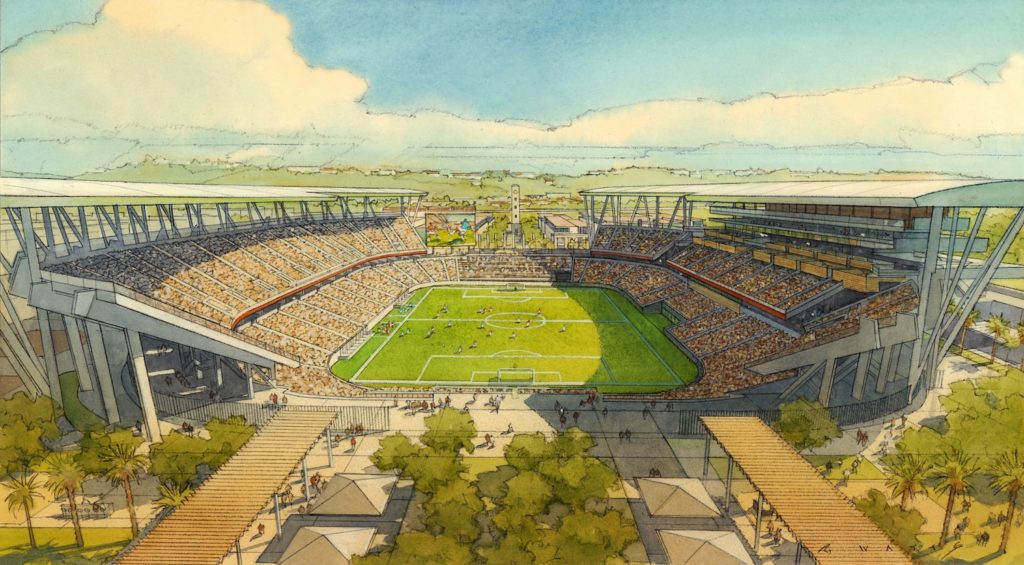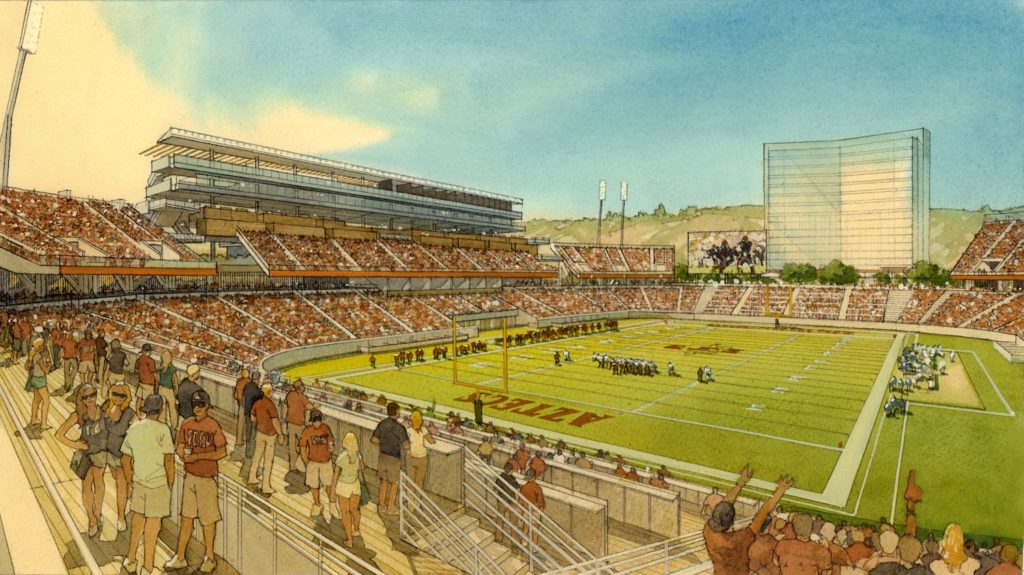With San Diego voters scheduled to vote on two proposed redevelopments of the current SDCCU Stadium site, it’s a certainty we’ll see plenty of sports action on the site—and there’s room for MLS in both.
At their core, both proposals are for a higher-density redevelopment of the SDCCU Stadium (formerly Qualcomm Stadium) site, as a sea of parking surrounding the stadium would make way for a sports facility, a public park along the San Diego River, and more. The SoccerCity proposal from FS Investors would authorize what’s become an accepted model for a modern sports development: a stadium (in this case, a new MLS facility) surrounded by apartments/condos, retail, entertainment and more.
The SDSU West proposal from Friends of SDSU is slightly different: while there would be some development, the emphasis would be a new outpost for San Diego State University, complete with 1.5M square feet for classrooms, public-private partnerships, research space and a new stadium for the Aztecs football team. Technically, SDSU isn’t part of the referendum: it’s been sponsored by the Friends of SDSU group (technically, SDSU is prohibited from any public activity like a voter referendum) and endorsed by the CSU Board of Trustees, calling for the city to sell the 132-acre stadium site at a fair price to SDSU.
Those are two dramatically different visions for a desirable parcel of land. Voters will be asked to weigh in on the two referendums on November 6, 2018.
But the choice isn’t necessarily between MLS and SDSU football. The SoccerCity developers say their plan could include San Diego State football as part of a 33,500-capacity stadium and the SDSU West proponents say they’re willing to work with MLS on sharing a new stadium seating 35,000 for college football and 25,000 for pro soccer—and expandable should the NFL return to San Diego. There were talks between FS Investors and SDSU in the past, but those broke down before a final agreement was reached. If voters approve both, the proposal garnering the most votes will prevail.
For San Diego State University Athletic Director John David Wicker, the decision isn’t between MLS soccer and Aztec football. His position: fans can have it both ways with the SDSU stadium plan, as the current blueprint calls for a facility that works for both pro soccer and college football, as well as a slew of other events.
“When we began discussions on a new stadium, we told Populous and JMI Sports to plan for college football, for MLS, as well as other events you’d want there, like concerts,” Wicker said in describing what he called a hybrid facility.
Wicker is familiar with the needs of professional soccer—at Georgia Tech, he negotiated the deal that set up Atlanta United FC at Bobby Dodd Stadium until Mercedes-Benz Stadium was completed—and knows what works for both soccer and football.
“I like the steeper rakes you see in soccer, so as we look at the stadium, it will be intimate like a soccer stadium, but it will have the sightlines for football as well,” he said. That includes flexible space that could be used for a soccer supporter section.
And that’s the key to this stadium being successful: being used for more than one purpose. “We couldn’t afford a stadium being used only six or seven times a year,” Wicker said. “You want as many events as you can possibly get.”
That flexibility, Wicker adds, should assure San Diego voters that MLS would still be a viable part of a new San Diego State facility.
“We’re keeping everyone informed, and if we get the opportunity to build the stadium, we’re interested in looking at hosting soccer,” he said.
The actual stadium design will feature 18 garden areas/neighborhoods throughout the facility, with a large concourse, an open design and concourse designed for socializing, lots of outdoor space and seating, and plenty of shade. Portable cabanas could be moved depending on the event. Flexibility is a central part of the plan: there will be room for food trucks along with permanent food halls.
The referendum, he adds, is just the beginning of the process. If the SDSU West proposal is approved by voters, it launches further efforts that includes negotiations with the city over the price of the land, the exact design of the stadium (which will undoubtedly include talks with MLS), and fundraising for the project. Which means there’s a long way to go before that first Aztecs kickoff in a new facility.
Images courtesy of Friends of SDSU.


